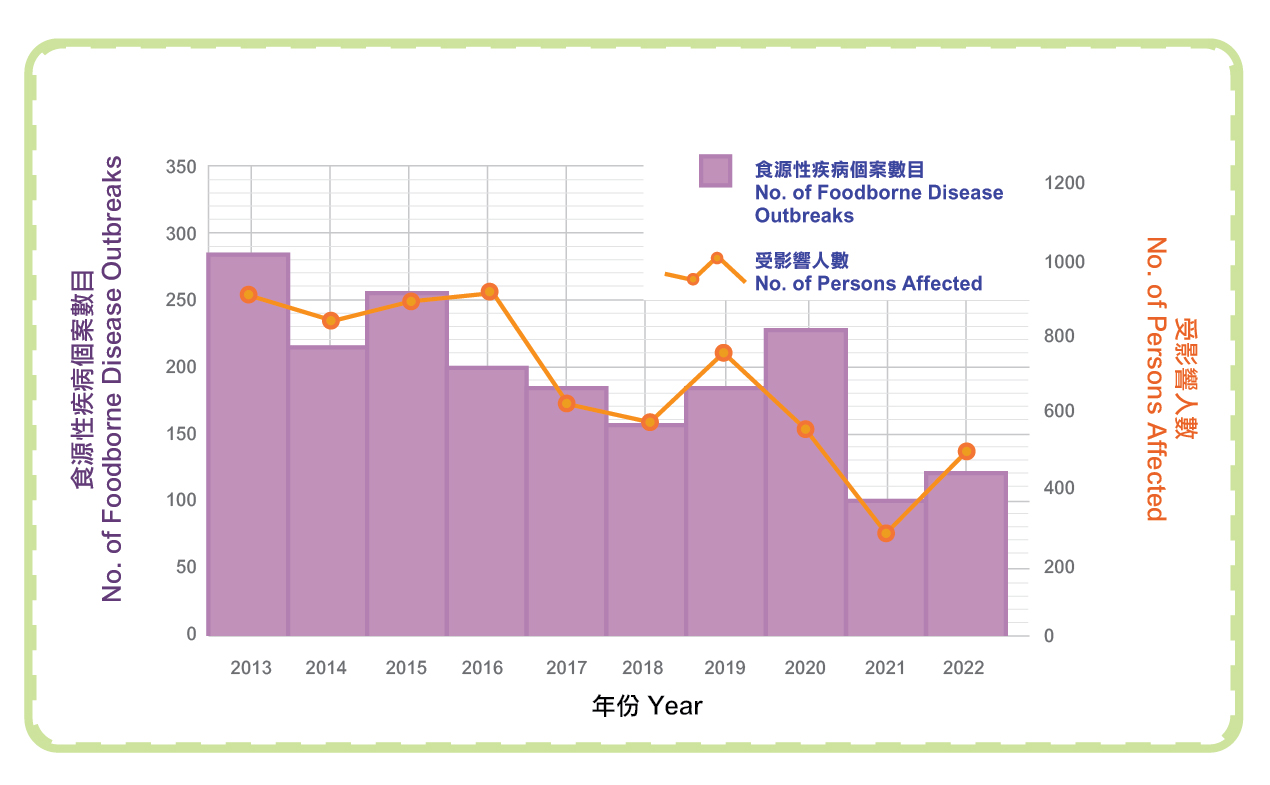
Food Safety Focus (200th Issue, March 2023)– Article 1
Review of Food Poisoning Outbreaks Related to Food Premises and Food Business in 2022
Reported by Dr. Lousia CHOI, Medical & Health Officer,
Risk Management Section, Centre for Food Safety
This article reviews the food poisoning outbreaks (FPOs) related to local food premises and food business reported to the Centre for Food Safety (CFS) of the Food and Environmental Hygiene Department (FEHD) in 2022.
Food Poisoning Outbreaks Related to Local Food Premises and Food Business
In 2022, the CFS received 117 FPO referrals from the Department of Health (DH), affecting 500 persons. The FPO statistics in food premises and food business remained at the low side in past two years and this may be attributed to the stringent COVID-19 anti-pandemic measures from shortened business hours and fewer meal gatherings.

Figure 1: Number of food poisoning outbreaks related to food premises and food business and the corresponding number of persons affected from 2013 to 2022.
Causative Agents and Contributing Factors
Bacterial pathogens remained the leading cause (66.1%) of FPOs in 2022. Salmonella (56.4%) topped the list, followed by Vibrio parahaemolyticus (35.6%), Clostridium perfringens (3%) and Staphylocccus aureus (3%). Viral causes accounted for 23.6% of all FPOs with Norovirus accounted for majority of viral cases (96.7%). Biochemical cases (such as histamine and ciguatera toxin etc.) increased from 6% in 2021 to 9.4% in 2022. Improper holding temperature (23.3% of all contributing factors), contamination by utensil (21.3%) and contamination by raw food (20.8%) were the three most frequently identified contributing factors for FPOs in 2022.
Highlights on Food Poisoning Outbreaks in 2022
Food Poisoning Outbreaks involving lava cake related to Salmonella species
In November 2022, the CFS received four FPOs related to the consumption of lava cake at a local food premises, involving 10 persons. Field investigation at the food premises revealed that although pasteurised egg solution was used to produce the lava cake, contamination could occur as the same egg beater was used to process both unpasteurised eggs and pasteurised egg solution without cleaning. The egg batter was stored with raw meat in the same refrigerator. Investigation also revealed inadequate cooking of lava cake with core temperature below 55°C, which was below the CFS's recommended temperature (75°C) to kill pathogens.
The FEHD instructed the food premises to stop the sale of incriminated food immediately, conduct thorough cleansing and disinfection of the food premises and dispose of the remaining food. Health advice was given.
Laboratory investigation revealed Salmonella Enteriditis of same sequence type was detected in both the food sample and victim's stool. While pasteurised egg products should be used to prepare the lightly cooked or uncooked egg, this case clearly illustrated the importance of food handlers following Good Hygiene Practices (GHPs) to avoid cross-contamination of foods from other sources.
Food Poisoning Outbreaks involving Tuna products and Scombroid toxin
The CFS noted an increase in the number of scombroid fish poisoning from 2 cases in 2021 to 5 cases in 2022. Tuna fish was involved in all cases in 2022 which affected eight persons.
Investigations had been conducted at these five food premises and along their supply chain. Four cases involved prolonged storage of tuna fish at improper temperatures above 4°C at the food premises, whereas one case showed evidence of improper storage temperature before importation to Hong Kong, resulting in histamine formation. These cases highlighted the importance of proper storage temperature along the whole processing chain for fish products with high histidine content, such as tuna, in order to minimise the risks of histamine formation and scombroid fish poisoning.
Scombrotoxin fish poisoning, also known as histamine poisoning, is caused by consuming fish that has been contaminated with high amounts of histamine. This is more likely to occur in fish high in a particular amino acid called histidine, such as tuna and sardines. When fish is handled and stored at improper temperatures after harvesting, the bacterial enzyme changes histidine in fish into histamine. Histamine may be produced at any point along the food chain, from fish harvesting to the point before consumption.
Conclusion
Local FPOs in food premises and food business remained at relatively low level due to anti-pandemic control measures in past two years. With the relaxation of anti-pandemic measures and more customers returning to on-premises dining, food businesses may face labour shortage that may pose food safety concern. Food businesses should remain vigilant and provide adequate food safety training to all food handlers, including permanent, temporary, or part-time staff. For the purpose of minimising the likelihood of food poisoning, the CFS has launched a new thematic website called "Safe Kitchen" to educate those who work with food on GHPs.

